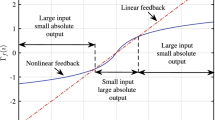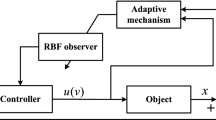Abstract
This paper deals with the adaptive neural network (NN) control problem for a class of pure-feedback systems with time-varying constrained states and unknown backlash-like hysteresis. First of all, the considered plant is transferred into a strict feedback system on account of the implicit function theorem and mean value theorem. Then, the time-varying Barrier Lyapunov functions (BLFs) are integrated into the backstepping techniques so that all the states do not transgress the corresponding constraint boundary. This approach avoids the procedure of finding inverse, and therefore greatly improves the robustness of controller. At the same time, the radial basis function (RBF) NNs are employed to identify the unknown internal dynamics, which is a key operation in each step. Based on the Lyapunov stability analysis scheme, all the closed-loop signals are proved to be uniformly ultimately bounded (UUB), and the tracking error converges to a small neighborhood of the origin. Finally, two simulation examples are developed to further verify the proposed control strategy.
Similar content being viewed by others
References
B. Jiang, H. R. Karimi, Y. G. Kao, and C. C. Gao, “Adaptive control of nonlinear semi-markovian jump TS fuzzy systems with immeasurable premise variables via sliding mode observer,” IEEE transactions on Cybernetics, 2018. DOI: 10.1109/TCYB. 2018.2874166.
Santra S., Karimi H. R., Sakthivel R., and S. M. Anthoni, “Dissipative based adaptive reliable sampled-data control of time-varying delay systems,” International Journal of Control, Automation and Systems, vol. 14, no. 1, pp. 39–50, 2016.
J. Han, “From PID to active disturbance rejection control,” IEEE Transactions on Industrial Electronics, vol. 56, no. 3, pp. 900–906, 2009.
L. Liu, Y. J. Liu, and S. Tong, “Neural networks-based adaptive finite-time fault-tolerant control for a class of strict-feedback switched nonlinear systems,” IEEE Transactions on Cybernetics, vol. 49, no. 7, pp. 2536–2545, May 2018.
Z. Gao, Y. Huang, and J. Han, “An alternative paradigm for control system design,” Proceedings of the 40th IEEE Conference on Decision and Control, vol. 5, pp. 4578–4585, 2001.
C. Bai and Z. Zhang, “A least mean square based active disturbance rejection control for an inertially stabilized platform,” Optik, vol. 174, pp. 609–622, 2018.
T. Gao, Y. J. Liu, D. Li, and L. Liu, “Adaptive neural network-based control for a class of nonlinear pure-feedback systems with time-varying full state constraints,” IEEE/CAA Journal ofAutomatica Sinica, vol. 5, no. 5, pp. 923–933, 2018.
X. Zhao, H. Yang, H. R. Karimi, and Y. Z. Zhu, “Adaptive neural control of MIMO nonstrict-feedback nonlinear systems with time delay,” IEEE Transactions on Cybernetics, vol. 46, no. 6, pp. 1337–1349, 2016.
Y. Li, S. Sui, and S. Tong, “Adaptive fuzzy control design for stochastic nonlinear switched systems with arbitrary switchings and unmodeled dynamics,” IEEE Transactions on Cybernetics, vol. 47, no. 2, pp. 403–414, 2016.
W. He, S. Zhang, and S. S. Ge, “Adaptive control of a flexible crane system with the boundary output constraint,” IEEE Transactions on Industrial Electronics, vol. 61, no. 8, pp. 4126–4133, 2014.
Y. J. Liu, M. Gong, S. Tong, C. P. Chen, and D. J. Li, “Adaptive fuzzy output feedback control for a class of nonlinear systems with full state constraints,” IEEE Transactions on Fuzzy Systems, vol. 26, no. 5, pp. 2607–2617, January 2018.
Q. Zhou, L. Wang, C. Wu, H. Li, and H. Du, “Adaptive fuzzy control for nonstrict-feedback systems with input saturation and output constraint,” IEEE Transactions on Systems, Man, and Cybernetics: Systems, vol. 47, no. 1, pp. 1–12, 2017.
S. Zhao, H. Liang, P. Du, and S. Qi, “Adaptive NN finite-time tracking control of output constrained nonlinear system with input saturation,” Nonlinear Dynamics, vol. 92, no. 4, pp. 1845–1856, 2018.
K. P. Tee, S. S. Ge, and E. H. Tay, “Barrier lyapunov functions for the control of output-constrained nonlinear systems,” Automatica, vol. 45, no. 4, pp. 918–927, 2009.
S. Zhang, M. Lei, Y. Dong, and W. He, “Adaptive neural network control of coordinated robotic manipulators with output constraint,” IET Control Theory and Applications, vol. 10, no. 17, pp. 2271–2278, 2016.
J. Xu, “Adaptive fault tolerant tracking control for a class of stochastic nonlinear systems with output constraint and actuator faults,” Systems and Control Letters, vol. 107, pp. 100–109, 2017.
Y. J. Liu and S. Tong, “Barrier Lyapunov functions-based adaptive control for a class of nonlinear pure-feedback systems with full state constraints,” Automatica, vol. 64, pp. 70–75, 2016.
Z. L. Tang, S. S. Ge, K. P. Tee, and W. He, “Robust adaptive neural tracking control for a class of perturbed uncertain nonlinear systems with state constraints,” IEEE Transactions on Systems Man and Cybernetics: Systems, vol. 46, no. 12, pp. 1618–1629, 2016.
B. Niu and J. Zhao J, “Output tracking control for a class of switched non-linear systems with partial state constraints,” IET Control Theory and Applications, vol. 7, no. 4, pp. 623–631, 2013.
K. P. Tee and S. S. Ge, “Control of nonlinear systems with partial state constraints using a barrier lyapunov function,” International Journal of Control, vol. 84, no. 12, pp. 2008–2023, 2011.
Z. Chen, Z. Li, and C. P. Chen, “Adaptive neural control of uncertain MIMO nonlinear systems with state and input constraints,” IEEE Transactions on Neural Networks and Learning Systems, vol. 28, no. 6, pp. 1318–1330, 2017.
Y. Liu, H. Ma, and H. Ma, “Adaptive fuzzy fault-tolerant control for uncertain nonlinear switched stochastic systems with time-varying output constraints,” IEEE Transactions on Fuzzy Systems, vol. 26, no. 5, pp. 2487–2498, March 2018.
L. Liu, Y. J. Liu, and S. C. Tong “Fuzzy based multi-error constraint control for switched nonlinear systems and its applications,” IEEE Transactions on Fuzzy Systems, 2018. DOI: 10.1109/TFUZZ.2018.2882173
B. S. Kim, and S. J. Yoo, “Approximation-based adaptive control of uncertain non-linear pure-feedback systems with full state constraints,” IET Control Theory and Applications, vol. 8, no. 17, pp. 2070–2081, 2014.
W. Meng, Q. Yang, J. Si, and Y. Sun, “Consensus control of nonlinear multiagent systems with time-varying state constraints,” IEEE Transactions on Cybernetics, vol. 47, no. 8, pp. 2110–2120, 2017.
B. Fan, Q. Yang, K. Wang, J. Xu, and Y. Sun, “Transient stability enhancement control of power systems with time-varying constraints,” IET Generation, Transmission and Distribution, vol. 10, no. 13, pp. 3251–3263, 2016.
B. Chen, X. Liu, K. Liu, and C. Lin, “Fuzzy approximation-based adaptive control of nonlinear delayed systems with unknown dead zone,” IEEE Transactions on Fuzzy Systems, vol. 22, no. 2, pp. 237–248, 2014.
B. Xiao, Q. Hu, and Y. Zhang, “Adaptive sliding mode fault tolerant attitude tracking control for flexible spacecraft under actuator saturation,” IEEE Transactions on Control Systems Technology, vol. 20, no. 6, pp. 1605–1612, 2012.
F. Wang, Z. Liu, Y. Zhang, and C. P. Chen, “Adaptive fuzzy control for a class of stochastic pure-feedback nonlinear systems with unknown hysteresis,” IEEE Transactions on Fuzzy Systems, vol. 24, no. 1, pp. 140–152, 2016.
Z. Liu, G. Lai, Y. Zhang, and C. L. Chen, “Adaptive neural output feedback control of output-constrained nonlinear systems with unknown output nonlinearity,” IEEE Transactions on Neural Networks and Learning Systems, vol. 26, no. 8, pp. 1789–1802, 2017.
H. Wang, P. X. Liu, and S. Liu, “Adaptive neural synchronization control for bilateral teleoperation systems with time delay and backlash-like hysteresis,” IEEE Transactions on Cybernetics, vol. 47, no. 10, pp. 3018–3026, 2017.
Y. Liu and Y. Lin, “Global adaptive output feedback tracking for a class of non-linear systems with unknown backlash-like hysteresis,” IET Control Theory and Applications, vol. 8, no. 8, pp. 927–936, 2014.
H. A. Yousef, M. Hamdy, and K. Nashed, “Li adaptive fuzzy controller for a class of nonlinear systems with unknown backlash-like hysteresis,” International Journal of Systems Science, vol. 48, no. 12, pp. 1–12, 2017.
Z. Yu, S. Li, Z. Yu, and F. Li, “Adaptive neural output feedback control for nonstrict-feedback stochastic nonlinear systems with unknown backlash-like hysteresis and unknown control directions,” IEEE Transactions on Neural Networks and Learning Systems, vol. 29, no. 4, pp. 1147–1160, 2017.
G. Lai, Z. Liu, Y. Zhang, C. L. Chen, and S. Xie, “Asymmetric actuator backlash compensation in quantized adaptive control of uncertain networked nonlinear systems,” IEEE Transactions on Neural Networks and Learning Systems, vol. 28, no. 2, pp. 294–307, 2017.
Y. Wang, X. Yang, and H. Yan, “Reliable fuzzy tracking control of near-space hypersonic vehicle using aperiodic measurement information,” IEEE Transactions on Industrial Electronics, 2019. DOI: 10.1109/TIE.2019.2892696
C. Y. Su, Y. Stepanenko, J. Svoboda, and T. P. Leung, “Robust adaptive control of a class of nonlinear systems with unknown backlash-like hysteresis,” IEEE Transactions on Automatic Control, vol. 45, no. 12, pp. 2427–2432, 2000.
L. Dou, P. Su, Q. Zong, and Z. Ding, “Fuzzy disturbance observer-based dynamic surface control for air-breathing hypersonic vehicle with variable geometry inlets,” IET Control Theory and Applications, vol. 12, no. 1, pp. 10–19, 2018.
B. Xu, Z. Shi, C. Yang, and F. Sun, “Composite neural dynamic surface control of a class of uncertain nonlinear systems in strict-feedback form,” IEEE Transactions on Cybernetics, vol. 44, no. 12, pp. 2626–2634, 2017.
Y. Y. Wang, H. R. Karimi, H. K. Lam, and H. Shen, “An improved result on exponential stabilization of sampled-data fuzzy systems,” IEEE Transactions on Fuzzy Systems, vol. 26, no. 6, pp. 3875–3883, 2018.
Author information
Authors and Affiliations
Corresponding author
Additional information
Recommended by Editor Hamid Reza Karimi. This work is supported in part by the National Natural Science Foundation of China under Grants 61803190, 61622303, 61603164, 61773188, 61803189, in part by the Program for Liaoning Innovative Research Team in University under Grant LT2016006, in part by the Fundamental Research Funds for the Universities of Liaoning Province under Grant JZL201715402.
Li Tang received the B.S. degree in information and computing science and the M.S. degree in applied mathematics from the Liaoning University of Technology, Jinzhou, China, in 2010 and 2014, respectively. She received the Ph.D. degree with the College of Information Science and Engineering, Northeastern University, Shenyang, China, in 2018. She is currently a Lecturer with the Liaoning University of Technology, Jinzhou. Her current research interests include switched systems, constrained systems and neural-network-based adaptive control.
Dongjuan Li received the B.S. degree in Applied Chemistry from Shenyang University of Technology, China, in 2003. She received the M. S. degree in Chemical Engineering Technology from Dalian Polytechnic University, in 2007. She is currently an Associate Professor with Chemical and Environmental Engineering, Liaoning University of Technology. Her research interests include process control, adaptive control, nonlinear control, neural network control.
Rights and permissions
About this article
Cite this article
Tang, L., Li, D. Time-varying Barrier Lyapunov Function Based Adaptive Neural Controller Design for Nonlinear Pure-feedback Systems with Unknown Hysteresis. Int. J. Control Autom. Syst. 17, 1642–1654 (2019). https://doi.org/10.1007/s12555-018-0745-y
Received:
Revised:
Accepted:
Published:
Issue Date:
DOI: https://doi.org/10.1007/s12555-018-0745-y




